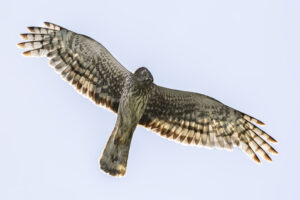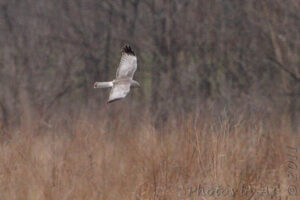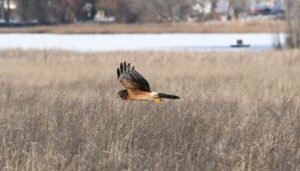Northern Harrier, Circus hudsonius
Bill Rowe
Our first bird of the New Year is one of North America’s most widespread raptors, apt to be seen virtually anywhere in open country at one time of year or another—farther north in the breeding season, farther south in the winter, as with so many birds. The Northern Harrier is obviously a far cry from the little Brown Creeper (coming soon), but they do share one thing: both of them are unique in their shape and behavior and can usually be identified immediately that way, before any colors or markings are noted. The harrier is usually seen coursing low over a prairie, a marsh, or a farm field, its long wings held at a shallow angle and its long tail helping it maneuver and change direction as it hunts for small mammals and birds. Seen from above, its white rump patch adds certainty (if any more was needed) to the observation. Since we have only one species in our part of the world, there is nothing else that normally looks and acts this way. Up close, in a scope view or a photograph, another unique feature appears: a circular facial rim outlining an owl-like disk of feathers that serves to focus sounds, helping the harrier locate its prey even when unseen. Elsewhere, harriers may present more of an identification problem, as in parts of Europe, where up to four species can occur. Various breeding bird surveys, migration counts, Christmas Bird Counts, and other studies have come up with a patchwork of estimates and guesses as to the Northern Harrier’s history and current population; the picture seems to show increases here and decreases there, with perhaps an overall slow decline as we have gradually lost wetland, prairie, and fallow farmland. Nonetheless, the harrier is still a common bird and a welcome one, a favorite with many birders. Historical note: In earlier American publications, prior to the 1960’s, this bird was the Marsh Hawk.
IDENTIFICATION: The text above tells you what to watch for as you scan the fields and marshes of harrier country, and the white rump (seen only from above) is a constant for all ages and both sexes. The only real problem arises when you see a harrier high overhead; that context is unusual enough that you may mistake it for various other raptors, but the long wings (sometimes pointed, sometimes not) and long tail should help. The photos below will help distinguish three types: adult females (white with streaks underneath), adult males (gray above with black wingtips), and juveniles of both sexes (rufous to orange underneath; see also the banner photo).
ST. LOUIS STATUS: A regular migrant and winter resident. Not known to nest in our area, but may show up in its southbound migration as early as August.
Learn more and listen to the calls of Northern Harriers here.


Adult female
Adult male
Photo Credit: Al Smith

Juvenile




